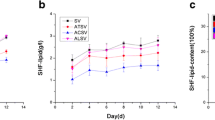Tamarind wastes such as tamarind husk, pulp, seeds, fruit and the effluent generated during tartaric acid extraction were used as supplements to evaluate their effects on alcohol production from cane molasses using yeast cultures. Small amounts of these additives enhanced the rate of ethanol production in batch fermentations. Tamarind fruit increased ethanol production (9.7%, w/v) from 22.5% reducing sugars of molasses as compared to 6.5% (w/v) in control experiments lacking supplements after 72 h of fermentation. In general, the addition of tamarind supplements to the fermentation medium showed more than 40% improvement in ethanol production using higher cane molasses sugar concentrations. The direct fermentation of aqueous tamarind effluent also yielded 3.25% (w/v) ethanol, suggesting its possible use as a diluent in molasses fermentations. This is the first report, to our knowledge, in which tamarind-based waste products were used in ethanol production.
Similar content being viewed by others
Author information
Authors and Affiliations
Additional information
Received 2 April 1998/ Accepted in revised form 13 November 1998
Rights and permissions
About this article
Cite this article
Patil, B., Gokhale, D., Bastawde, K. et al. The use of tamarind waste to improve ethanol production from cane molasses. J Ind Microbiol Biotech 21, 307–310 (1998). https://doi.org/10.1038/sj.jim.2900593
Issue Date:
DOI: https://doi.org/10.1038/sj.jim.2900593




